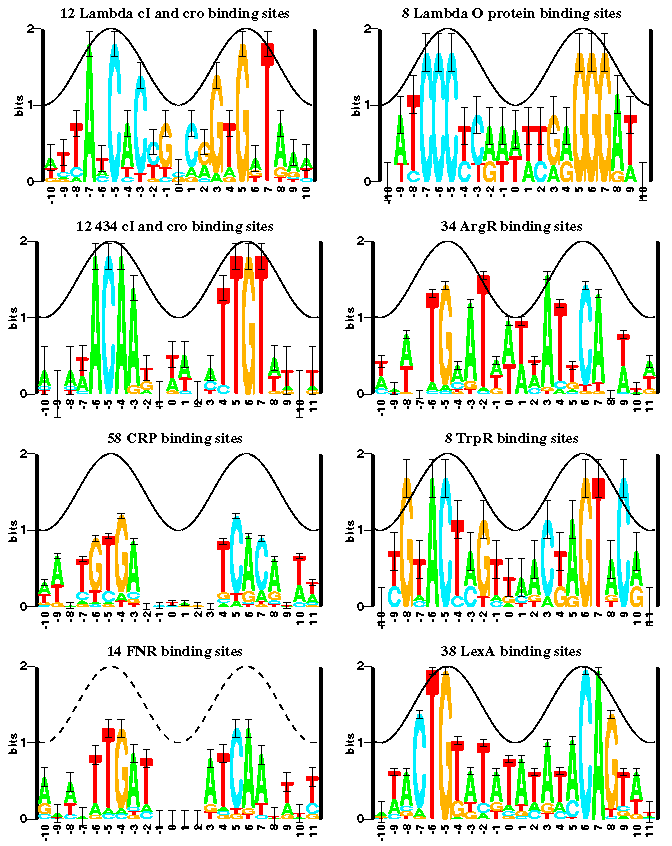Difference between revisions of "CSC334 lab7"
| Line 4: | Line 4: | ||
::A sequence logo in bioinformatics is a graphical representation of the sequence conservation of nucleotides (in a strand of DNA/RNA) or amino acids (in protein sequences) [http://en.wikipedia.org/wiki/Sequence_logo] | ::A sequence logo in bioinformatics is a graphical representation of the sequence conservation of nucleotides (in a strand of DNA/RNA) or amino acids (in protein sequences) [http://en.wikipedia.org/wiki/Sequence_logo] | ||
| − | ::To create sequence logos, related DNA, RNA or protein sequences, or DNA sequences that have common conserved binding sites, are aligned so that the most conserved parts create good alignments. A sequence logo can then be created from the conserved multiple sequence alignment. The sequence logo will show how well residues are conserved at each position: the fewer the number of residues, the higher the letters will be, because the better the conservation is at that position. Different residues at the same position will be scaled according to their frequency. Sequence logos can be used to represent conserved DNA binding sites, where transcription factors bind. [http://en.wikipedia.org/wiki/Sequence_logo] | + | ::To create sequence logos, related DNA, RNA or protein sequences, or DNA sequences that have common conserved binding sites, are aligned so that the most conserved parts create good alignments. A sequence logo can then be created from the conserved multiple sequence alignment. '''The sequence logo will show how well residues are conserved at each position: the fewer the number of residues, the higher the letters will be, because the better the conservation is at that position'''. Different residues at the same position will be scaled according to their frequency. Sequence logos can be used to represent conserved DNA binding sites, where transcription factors bind. [http://en.wikipedia.org/wiki/Sequence_logo] |
| + | |||
| + | For this lab we will use 8 different sequences: | ||
| + | |||
| + | <code><pre> | ||
| + | seq[0] = "CCCATTGTTCTC"; | ||
| + | seq[1] = "TTTCTGGTTCTC"; | ||
| + | seq[2] = "TCAATTGTTTAG"; | ||
| + | seq[3] = "CTCATTGTTGTC"; | ||
| + | seq[4] = "TCCATTGTTCTC"; | ||
| + | seq[5] = "CCTATTGTTCTC"; | ||
| + | seq[6] = "TCCATTGTTCGT"; | ||
| + | seq[7] = "CCAATTGTTTTG"; | ||
| + | </pre></code> | ||
| + | |||
| + | They are shown here as taken from a Processing program where the sequences are stored in an array of 8 strings: | ||
| + | |||
| + | <code><pre> | ||
| + | String seq[8]; | ||
| + | </pre></code> | ||
Revision as of 12:30, 4 August 2008
A good definition of sequence logos can be found in Wikipedia:
- A sequence logo in bioinformatics is a graphical representation of the sequence conservation of nucleotides (in a strand of DNA/RNA) or amino acids (in protein sequences) [1]
- To create sequence logos, related DNA, RNA or protein sequences, or DNA sequences that have common conserved binding sites, are aligned so that the most conserved parts create good alignments. A sequence logo can then be created from the conserved multiple sequence alignment. The sequence logo will show how well residues are conserved at each position: the fewer the number of residues, the higher the letters will be, because the better the conservation is at that position. Different residues at the same position will be scaled according to their frequency. Sequence logos can be used to represent conserved DNA binding sites, where transcription factors bind. [2]
For this lab we will use 8 different sequences:
seq[0] = "CCCATTGTTCTC";
seq[1] = "TTTCTGGTTCTC";
seq[2] = "TCAATTGTTTAG";
seq[3] = "CTCATTGTTGTC";
seq[4] = "TCCATTGTTCTC";
seq[5] = "CCTATTGTTCTC";
seq[6] = "TCCATTGTTCGT";
seq[7] = "CCAATTGTTTTG";
They are shown here as taken from a Processing program where the sequences are stored in an array of 8 strings:
String seq[8];
